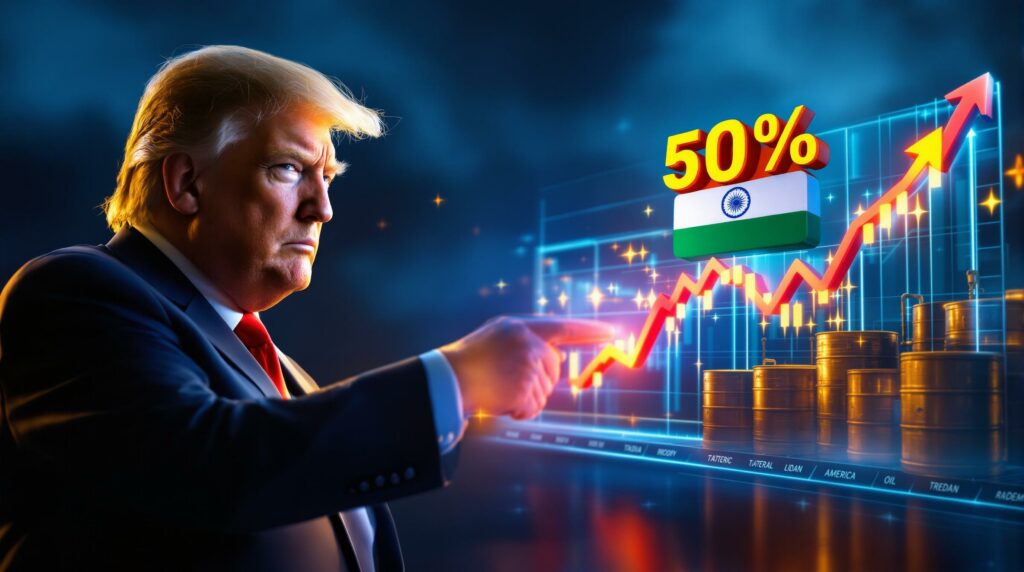Trump's Tariff Strategy on Indian Imports: The Russian Oil Connection
Understanding Trump's tariff policies on Indian imports requires examining the complex relationship between global oil markets, international trade, and geopolitical strategies. The proposed tariffs specifically target India's continued purchases of Russian crude oil, creating ripple effects across global energy markets and international trade relationships.
What Are Trump's New Tariffs on Indian Imports?
Understanding the Tariff Announcement
President Trump recently announced a 25% tariff on numerous Indian imports, citing India's continued purchases of Russian crude oil as the primary justification. This controversial decision represents one of the most aggressive trade actions taken against India by a U.S. administration. The tariffs impact markets by potentially affecting up to $87 billion worth of Indian exports to the United States.
The move marks a significant shift in U.S.-India trade relations, which have generally been strengthening in recent years. While the tariff is framed as a response to energy procurement decisions, it effectively creates a trade barrier that could disrupt global supply chains and raise prices for American consumers of Indian goods.
Timeline and Implementation Details
The tariff announcement came as part of a broader trade strategy that Trump has been developing, with the formal announcement made last week. While the specifics of implementation remain under development, the administration has indicated these tariffs would apply to a wide range of Indian products, potentially excluding only certain strategic categories.
The announcement has already caused market disruption, with Indian refiners reportedly suspending new Russian oil orders while they assess the situation. Industry experts anticipate a phased implementation approach, potentially giving businesses on both sides time to adjust supply chains and procurement strategies.
Market Alert: Following Trump's announcement, trading activity in affected sectors showed immediate volatility, with Indian exporters of textiles, pharmaceuticals, and technology services experiencing particular uncertainty about future market access.
Why Is Trump Targeting India's Russian Oil Purchases?
The Geopolitical Oil Strategy
Trump's tariff announcement represents a significant shift in U.S. policy toward India's energy procurement practices. The move appears designed to pressure India into reducing or eliminating its Russian crude oil imports, which have grown substantially since 2022. This approach aligns with broader Western efforts to limit Russia's oil export revenues, though it marks a departure from previous U.S. administrations that had encouraged global oil market stability regardless of source.
The strategy reflects a prioritization of geopolitical objectives over traditional free market principles in global oil trade. By using trade tariffs as leverage against a third country's energy decisions, the administration is effectively expanding the toolbox of energy diplomacy beyond direct sanctions on producer countries.
Statistical Context of India's Russian Oil Imports
India currently imports approximately 1.7 million barrels per day (bpd) of Russian crude oil, making it one of Russia's largest oil customers. This volume represents a dramatic increase from pre-2022 levels when India purchased minimal amounts of Russian crude.
According to economic analyses, India has saved approximately $3.8 billion through discounted Russian crude purchases, though these savings could potentially be dwarfed by the threatened tariffs on $87 billion worth of exports to the U.S.
- Pre-2022: Minimal Russian crude imports
- Current level: 1.7 million bpd
- Financial impact: $3.8 billion in savings vs. $87 billion export risk
The Price Discount Factor
Russian crude has been trading at significant discounts compared to international benchmarks since 2022, making it particularly attractive to price-sensitive importers like India. These discounts have typically ranged from $5-20 per barrel depending on market conditions, creating strong economic incentives for Indian refiners to maximize Russian purchases despite Western pressure to reduce them.
The discount varies based on grade, logistics, and market conditions, but has consistently provided Indian refiners with a competitive advantage in producing refined products for both domestic consumption and export markets. This price advantage has been particularly valuable for India's growing economy, which remains highly sensitive to energy costs.
How Has India Responded to Trump's Tariff Threat?
Official Government Position
The Indian government has signaled it will not bow to external pressure regarding its energy procurement decisions. New Delhi's initial response suggests a prioritization of energy security and economic competitiveness over compliance with U.S. trade demands.
Indian officials have emphasized their country's sovereign right to determine its own energy suppliers based on national interest rather than external political pressure. This stance reflects India's broader foreign policy of strategic autonomy, which has historically resisted alignment with any single global power bloc.
Refinery and Market Reactions
Indian state refiners reportedly paused new Russian crude oil orders immediately following Trump's announcement, indicating at least temporary market disruption. However, industry analysts suggest this pause may be strategic rather than indicative of a long-term policy shift.
Private refiners in India have not publicly disclosed their procurement plans, creating uncertainty about the overall market impact. The difference in response between state-owned and private refiners highlights the complex interplay between commercial interests and geopolitical considerations in India's energy sector.
Economic Impact Assessment
According to analysis from the State Bank of India, if India were to completely stop Russian oil imports, its oil import bill could increase by approximately $9 billion in the current fiscal year and by an additional $11 billion in the following fiscal year.
This significant cost increase would impact not only India's trade balance but potentially the competitiveness of its export goods as well. The cascading effects could include:
- Higher production costs for Indian manufacturers
- Reduced competitiveness in global export markets
- Potential inflationary pressure in the domestic economy
- Widening trade deficit with oil-producing nations
Warren Patterson, head of commodity strategy at ING, summarized the dilemma succinctly: "If you look at the size of India's trade with the US, and look at how much savings India gets from buying Russian crude, it's pretty clear what India would do. Are you going to risk up to $87 billion worth of exports to the US in order to save a few billion from oil discounts?"
What Are the Global Oil Market Implications?
Potential Supply Disruption Scenarios
If India complies with Trump's demands and ceases Russian oil purchases, approximately 1.7 million barrels per day of Russian crude would need to find alternative buyers or be removed from the market. This disruption could expand to over 2 million barrels daily if other countries like Turkey also halt Russian purchases in response to potential secondary tariffs.
Such a significant supply shift would likely create upward pressure on global oil prices. The redirection of such large volumes would test the flexibility of global oil trading systems and potentially expose structural limitations in alternative export routes for Russian producers.
Price Impact Projections
Oil market analysts suggest that removing Russian barrels from the global market would likely drive prices higher, potentially undermining one of Trump's stated preferences for lower oil prices. While OPEC+ is currently returning some production to the market, capacity constraints mean the group is not fully delivering on announced increases, limiting its ability to compensate for potential Russian export losses.
The oil price movements would be determined by several factors:
- Speed of supply disruption (immediate vs. gradual)
- OPEC+ response capacity and willingness
- Alternative buyer emergence (particularly China)
- Seasonal demand patterns
- Global economic growth trajectory
Alternative Supply Source Dynamics
Rather than shifting to U.S. crude, Indian refiners would likely return to their traditional Middle Eastern suppliers if Russian oil becomes economically unviable due to tariff pressures. This redirection of purchasing patterns would reshape global oil trade flows without necessarily benefiting U.S. energy exporters, as geographic and quality considerations often make Middle Eastern crude more suitable for Indian refineries.
According to Reuters analyst Gavin Maguire, the primary beneficiaries would be Middle Eastern producers who previously supplied India before Russian crude became economically attractive. These suppliers maintain the logistical advantages and appropriate crude qualities that align with Indian refining capabilities.
Technical Note: Many Indian refineries are technically optimized for processing specific gravity and sulfur content profiles found in Middle Eastern crudes, making a return to these suppliers technically straightforward despite potential price premiums compared to Russian alternatives.
What Is the Economic Dilemma for India?
Trade-off Between Export Revenue and Energy Costs
India faces a complex economic calculation: risking approximately $87 billion in exports to the United States versus preserving billions in savings from discounted Russian oil. The Economic Times has highlighted this dilemma, noting that while the U.S. is India's largest trade partner, energy costs fundamentally impact the competitiveness of Indian exports across all markets.
This creates a multi-dimensional economic challenge rather than a simple binary choice. Indian policymakers must consider:
- Direct export revenue risks to the U.S. market
- Indirect competitiveness impacts on global exports
- Domestic industrial productivity effects
- Currency stability implications
- Long-term strategic relationships with multiple trading partners
Domestic Price Stability Concerns
Energy costs significantly influence India's domestic inflation rates and economic stability. By accessing discounted Russian crude, Indian refiners have helped maintain more stable fuel prices domestically. A forced transition to higher-priced alternatives could potentially trigger inflationary pressures throughout the Indian economy at a time when price stability remains a key policy objective.
The retail fuel pricing mechanism in India makes consumer prices particularly sensitive to international crude costs, with potential political ramifications from price increases. This domestic consideration adds another layer of complexity to India's decision-making process beyond pure international trade calculations.
Long-term Energy Security Considerations
India remains dependent on imports for over 85% of its crude oil needs, making energy security a fundamental national priority. The government's resistance to external pressure on procurement decisions reflects this strategic vulnerability and the importance of maintaining diverse supply options rather than becoming overly dependent on any single source or region.
India's energy security strategy has evolved to prioritize:
- Supply diversification across multiple geographies
- Price optimization through competitive sourcing
- Strategic reserves development
- Domestic production enhancement
- Supplier relationship management independent of geopolitical alignments
How Does This Compare to Previous U.S. Energy Policies?
Policy Reversal From Previous Administration
Energy analysts have pointed out an apparent contradiction in U.S. policy approaches. As Bob McNally of Rapidan Energy Group noted, "Joe Biden went to India after the invasion of Ukraine and begged them to take Russian oil… so that crude prices would remain low, and they did. Now we're flipping around and saying, 'why are you taking all this oil.'" This policy reversal highlights the complex and sometimes contradictory nature of geopolitical energy strategies.
The shift demonstrates how energy policy objectives can vary dramatically between administrations, creating challenges for market participants attempting to make long-term investment and procurement decisions. This inconsistency can undermine U.S. credibility in energy diplomacy and create hesitancy among international partners to align with American policy preferences.
Sanctions Versus Tariffs Approach
Previous U.S. administrations typically relied on direct sanctions against specific countries or entities rather than broad tariffs against third countries engaged in legal trade. This shift to using tariffs as a tool to influence third-party energy procurement represents a significant evolution in U.S. trade and energy policy approaches.
The tariff approach offers different strategic advantages and limitations compared to direct sanctions:
| Direct Sanctions | Tariff Approach |
|---|---|
| Targets source country directly | Targets third-party customers |
| Requires international coordination | Can be implemented unilaterally |
| Often includes humanitarian exceptions | Broadly affects entire trade relationship |
| Clear legal framework and precedent | Novel application with uncertain legal boundaries |
| Directly impacts sanctioned activities | Creates indirect pressure through unrelated sectors |
Market Intervention Philosophy
Trump's approach suggests a more interventionist stance toward global oil markets than typically associated with Republican administrations, which have historically favored free-market principles. This intervention comes despite the fact that Russian crude oil itself is not currently under direct U.S. sanctions, making the tariff approach particularly noteworthy from a policy perspective.
The shift represents a potential blending of traditionally Republican trade assertiveness with a more managed approach to global energy markets, creating a unique policy combination that challenges conventional political categorizations of energy and trade philosophy.
What Are the Potential Outcomes of This Trade Conflict?
Scenario 1: India Reduces Russian Oil Purchases
If India yields to U.S. pressure and significantly reduces Russian crude imports, global oil prices would likely increase due to market disruption. This scenario could satisfy U.S. geopolitical objectives regarding Russia but might undermine economic goals related to energy affordability.
India would face higher energy costs but potentially preserve its valuable export market access to the United States. The transition costs would include both higher crude procurement expenses and potential refinery adjustments to process different crude slates optimally.
Scenario 2: India Maintains Russian Oil Purchases
Should India maintain its current Russian oil procurement levels despite the tariff threat, it would preserve energy cost advantages but potentially face significant export challenges in the U.S. market. This scenario might lead to accelerated efforts by India to diversify its export destinations and reduce dependence on the U.S. market over time.
The economic impact would depend on India's ability to redirect exports to alternative markets and the effectiveness of potential compensatory measures like:
- Currency adjustment to maintain export competitiveness
- Market diversification initiatives
- Domestic manufacturing subsidies
- Bilateral trade agreements with non-U.S. partners
- Potential retaliatory measures against U.S. exports to India
Scenario 3: Negotiated Compromise
A third possibility involves a negotiated solution where India agrees to partial reductions in Russian oil purchases in exchange for tariff modifications or exemptions. This face-saving compromise might address some U.S. concerns while allowing India to maintain aspects of its energy security strategy and export market access.
Such a compromise could include:
- Gradual reduction targets rather than immediate cessation
- Categorical exemptions for strategic industries
- Alternative compliance mechanisms
- Joint development of energy transition initiatives
- Enhanced bilateral cooperation in other domains
How Might Global Oil Markets Adapt?
Trade Flow Realignments
The global oil market would likely respond to any major disruption through trade flow realignments rather than absolute supply reductions. Russian crude diverted from India might find its way to less transparent markets or be blended and re-exported through intermediary countries, while India would increase purchases from Middle Eastern suppliers.
These realignments could create temporary inefficiencies and price dislocations as logistical systems adjust to new patterns. The physical characteristics of global oil trade—including vessel availability, shipping routes, port capacities, and storage infrastructure—would all require adaptation to accommodate new flow patterns.
Price Discovery Mechanisms
Oil price benchmarks would adjust to reflect new trading patterns and risk premiums associated with market disruption. The Brent-WTI spread and other key differentials might widen or narrow depending on how regional supply-demand balances shift in response to changing trade flows.
The complexity of these adjustments could temporarily reduce market transparency and price efficiency as participants adapt to new trading patterns and information flows. Derivative markets might experience volatility spikes during the transition period as hedging strategies adjust to new market realities.
Refinery Configuration Adaptations
Refineries optimized for specific crude slates might need to adjust their operations if forced to process different oil types. This technical challenge could create temporary inefficiencies and product yield shifts until refiners adapt to new feedstock patterns.
The adaptation process involves:
- Blend optimization to maintain consistent feedstock properties
- Operating parameter adjustments (temperature, pressure, catalyst conditions)
- Potential capital investments for handling different crude qualities
- Product slate modifications based on yield patterns
- Logistics and storage adjustments for new supply sources
What Are the Long-Term Strategic Implications?
Energy Security Versus Trade Relationships
This conflict highlights the growing tension between energy security imperatives and international trade relationships in an increasingly fragmented global economy. Countries may increasingly face difficult choices between securing affordable energy supplies and maintaining export market access.
This dynamic reflects a fundamental shift from the post-Cold War globalization paradigm toward a more compartmentalized international economic system where strategic considerations increasingly override pure economic efficiency. National security considerations are becoming more prominent in economic decision-making across multiple domains.
Acceleration of Trade Diversification Efforts
Nations vulnerable to trade pressure may accelerate efforts to diversify both their export markets and energy supply sources to reduce strategic vulnerabilities. This could lead to more regionalized trade patterns and complex supply chain arrangements designed to minimize exposure to any single market or supplier.
India specifically may intensify efforts to:
- Expand trade relationships with Europe, Southeast Asia, and Africa
- Develop alternative payment mechanisms less vulnerable to sanctions
- Invest in domestic energy production and renewable capacity
- Create strategic petroleum reserves to buffer supply disruptions
- Enhance refinery flexibility to process diverse crude types
Implications for Global Energy Governance
The Trump trade war impact challenges traditional models of global energy governance, which have typically relied on direct sanctions rather than indirect trade pressures. This approach may signal a broader shift toward using economic leverage across multiple domains to achieve energy policy objectives.
The precedent could encourage similar approaches by other major economies, potentially fragmenting the global energy market along geopolitical lines rather than economic efficiency. This evolution would challenge existing energy institutions and coordination mechanisms that were designed for a more integrated global market.
Frequently Asked Questions About Trump's India Tariffs
Are Russian Oil Exports to India Currently Sanctioned?
No, Russian crude oil exports to India are not currently under direct U.S. sanctions. The tariff approach represents an indirect method of pressuring India's procurement decisions rather than a direct prohibition on the oil trade itself. This distinction is important for understanding the legal and diplomatic context of the current situation.
How Much Could Oil
Interested in Staying Ahead of Market-Moving Resource Discoveries?
Discover why major mineral findings can lead to exceptional returns by exploring Discovery Alert's dedicated discoveries page, where their proprietary Discovery IQ model delivers real-time alerts on significant ASX discoveries, giving subscribers an immediate edge in the market. Begin your 30-day free trial today at https://discoveryalert.com.au/discoveries/.




